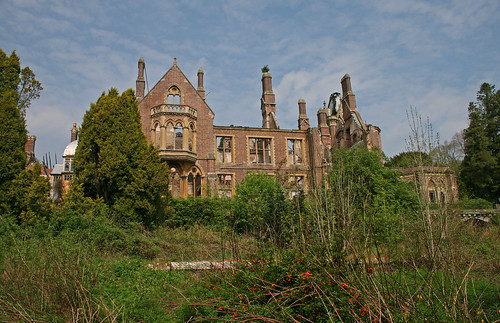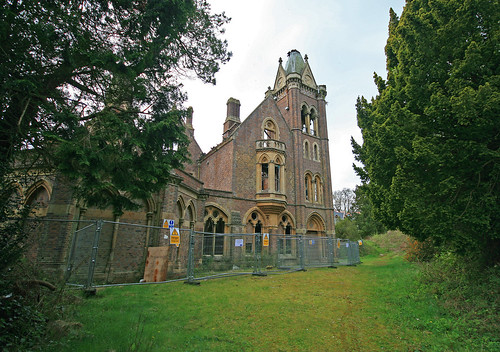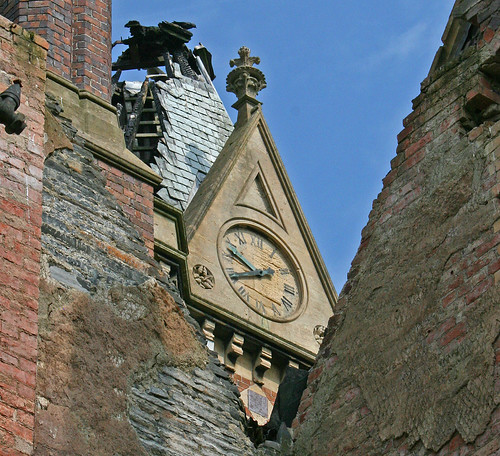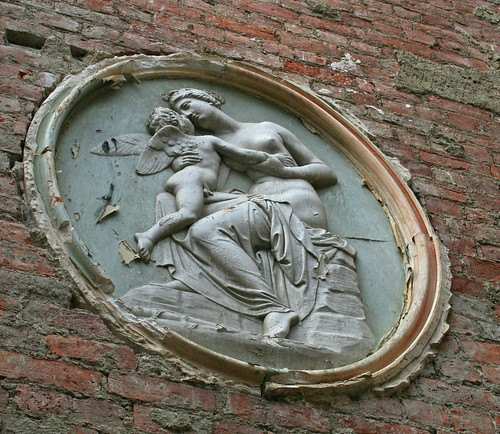Since I was a child, I'd heard stories about the fabulous Grade I Listed Gothic mansion (designed by Sir George Gilbert Scott and built between 1861-1866) high in the hills above Colwyn Bay. In the days before the Internet (remember them?), information about such places was scarce and it was only the odd news story in the North Wales Weekly News that provided any information. Even then, its actual location was a complete mystery and it was more by luck than planning that I caught sight of its high clock tower as I wandered along a back lane by Llangernyw in about 1997.
I took the opportunity to have a little wander around the outside of the mansion and a look through its Grade II Listed (but very overgrown) gardens. The terraced gardens are worth a visit by themselves; believed to contain over 1,200 species of exotic plants, many are said to have been planted by the botanist and horticulturalist Sir William Hooker or his son J. D. Hooker. Back in those days, the mansion was empty and, apart from some minor vandalism, was in fairly good condition. In fact, its condition was such that you could almost imagine that there was someone still living there, shades of Great Expectations!
In fact, the family that had built it (the Sandbachs) had long since departed and it had suffered a succession of institutional owners, culminating in a stint as a nursing home under the notorious ownership of Les Whittingham - a man from the Morecambe area who loved buying unusual buildings but who didn't like spending any money whatsoever on maintenance. The nursing home was eventually closed down by Clwyd County Council in the mid 1990s and it remained empty until Les Whittingham's death in about 1999. It was then put up for sale and was eventually sold to SFJ Limited, a Colwyn Bay property developer, who announced plans to develop the mansion into a luxury country house hotel, with about 90 log cabins in the grounds. The locals were none too keen on this plan and put up a spirited campaign of opposition. The battle between developer and community ended on the night of the 14th October 2004 when two youths broke into the mansion and set fire to it. Despite a determined effort by the Fire Service, the main section of the mansion was completely destroyed....
And there its history almost stops, for the mansion and its 50 acres of gardens were effectively abandoned and have been left to their gentle decline ever since. It's been up for sale for the last couple of years but no sale has been concluded, almost as if the Estate Agent didn't really want to sell it. In the meantime, the mansion itself deteriorates little by little every year and the brambles in the garden grow ever higher.
Update: January 2010: I hear that Hafodunos has finally been sold. I also understand that discussions have taken place with both Conwy Council (who are willing to issue a grant towards stabilisation works for the Hall) and CADW (regarding renovation grants). CADW have issued a grant of £21,000 for emergency stabilisation works.
I viewed the Estate twice in 2008; the full set of photos is on Flickr (see link at bottom of page) but here's a selection to give you a feel for how Hafodunos looks now. I thought it important to document it as fully as possible, before the decline becomes overwhelming:

Main frontage in 2008 (Photo Credit)

Side of the Mansion & Main Entrance in 2008 (Photo Credit)

The Conservatories in 2008 (Photo Credit)
 Looking up at the ruined Clocktower in 2008 (Photo Credit)
Looking up at the ruined Clocktower in 2008 (Photo Credit)


Beautiful hand carved stonework, depicting wild plants found in the gardens (Photo Credit)
A full set of photos taken on my visits to Hafodunos can be found on the Flickr website here.
A full set of photos taken on my visits to Hafodunos can be found on the Flickr website here.


.jpeg)











7 comments:
So so sad to see a once proud residence as in the 1954 photograph become such a ruin as it is today. How could something like this happen in such a relatively short space of time?
My wife and I have driven past on several ocasions in recent times and it is pitiful to see it in its present pathetic state.
Where were the various authorities in all of this - surely it would have been listed so where were Cadw for instance? I realise no-one could have done anything about the fire apart from the arsonists, but did Cadw or others have an involvement?
The primary responsibility for Listed Buildings lies with the Local Authority, in this case our old friend Conwy County Borough Council. They were urged on several occasions by various groups to either serve an Urgent Works Notice (which forces the owner to carry out essential repairs) or to consider a Compulsory Purchase order.
Unfortunately, they took no action whatsoever as Hafodunos deteriorated and have done nothing since the fire to carry out any work to stabilise the structure, protect the remaining artworks etc.
CCBC's track record on protecting Listed Buildings is abysmal - you'll know of Gwrych Castle in Abergele, which is also Grade I Listed (designated only for buildings deemed to be of exceptional architectural or historical importance). Gwrych is in just as bad a way as Hafodunos, another example of how it was allowed to deteriorate over just a few years into a complete ruin.
It's a sorry state of affairs...
About 3/4 years ago I was involved in an access improvement proposal at the main entrance of a prominent Llandudno building which I am sure you will know and recognise. A report had been produced in accordance with Disability Discrimination legislation and the issue was to try and come up with a scheme that would obviate two steps, one at the external door into the porch and the second from the porch into the main body of the building.
The architect came up with a plan to raise the porch floor level to that of the inside and then to have a platform outside with two steps and a ramp. The ramp was to have a simple, plain black painted rail (to match the black painted gutters and down spouts), to provide support for those using it.
The proposal went through the preliminary formalities but the body based in Cardiff to oversee ancient buildings, objected to the rail on the grounds that it would spoil the look of the building and was not required because of a certain BS standard for such ramps. A rail would only be required if the slope of the ramp was less than 1:20 and ours was exactly 1:20 so the surveyor/agent was against it and said it was not required. Can you imagine a ramp that has any slope without a handrail for support? And look at all the ramps along Mostyn Street, they all have rails and the buildings are probably all listed and are certainly in a conservation area.
My point here in relating this experience, is to perhaps show that when you least expect intervention, you get it. BUT when you expect it, it is quite often not forthcoming!
Nice story. I expect they happily intervene in situations where they know it wont cost them much to do so and they know you will comply with their ruling.
With Grade I Listed Buildings, the Listing (which is obviously supposed to protect the building against alteration/damage) can actually work against the best interests of the building, as it renders any maintenance work horrendously expensive and time consuming, so less scrupulous owners will just not bother doing anything.
Perhaps there should be some sort of annual maintenance/security allowance doled out to owners of Grade I buildings, as the present system certainly doesnt seem to be working very well. It would probably end up cheaper than the massive cost of renovation when a property becomes a ruin just because routine maintenance/security has been skimped on.
Your blog keeps getting better and better! Your older articles are not as good as newer ones you have a lot more creativity and originality now keep it up!
Has anyone read the book 'Hafodunos Hall - Triumph of the Martyr'? Jane
Yes, it's a very thorough and readable history of Hafodunos, although its been a couple of years since it was published and the recent ownership shenanigans would make an interesting new chapter.
Post a Comment